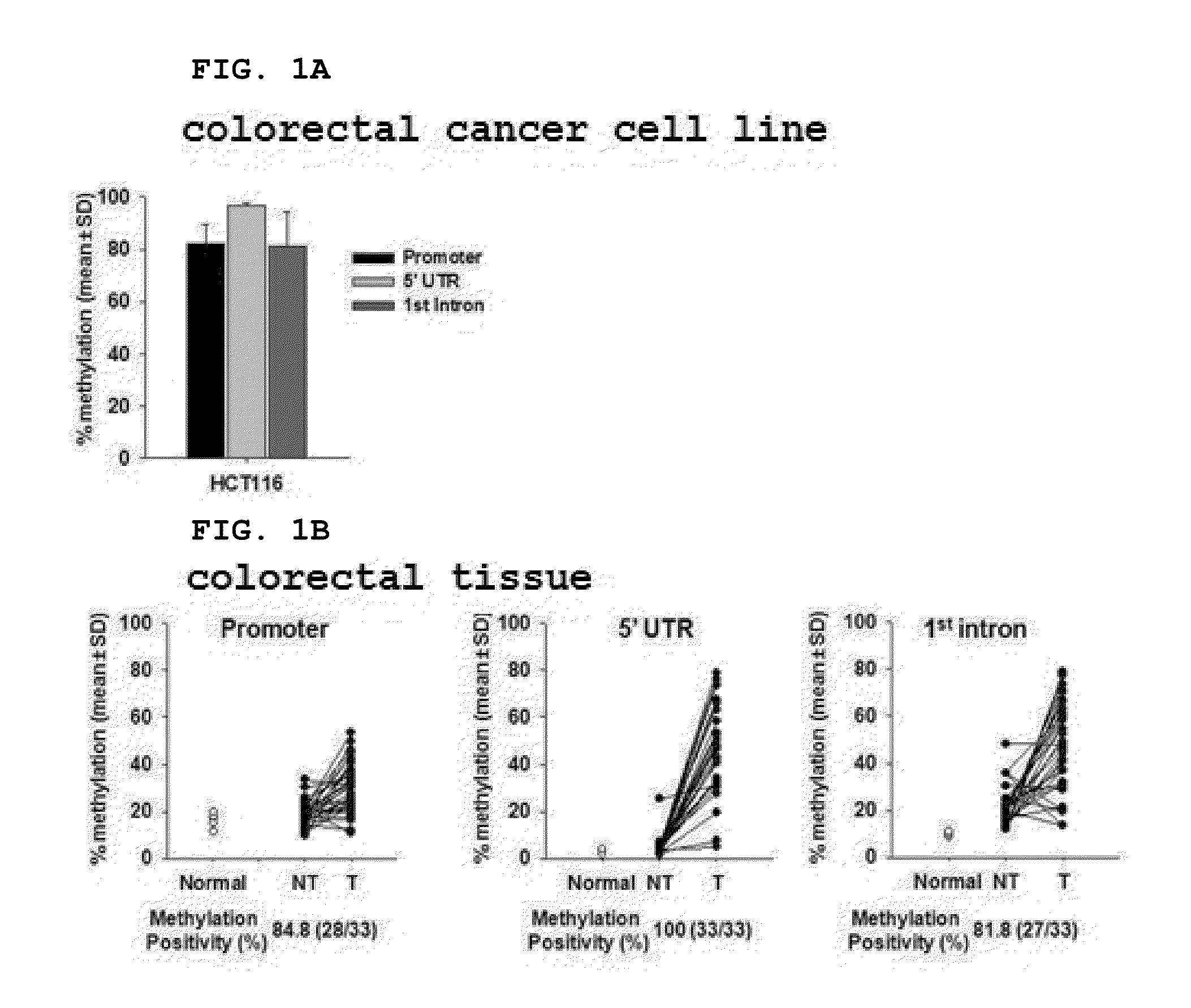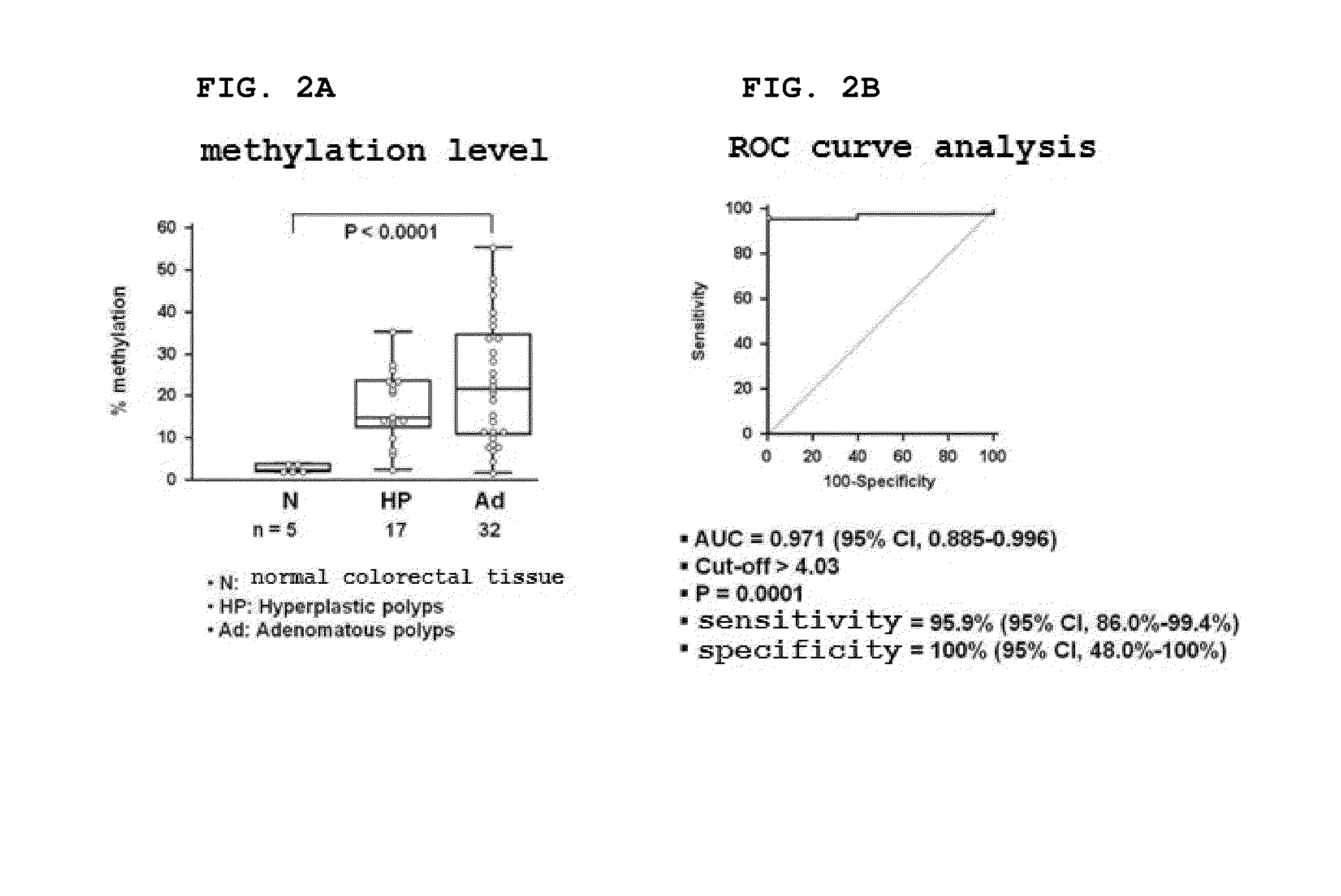Method for detecting precancerous lesions
a technology for cancer and lesions, applied in combinational chemistry, biochemistry apparatus and processes, library screening, etc., can solve the problems of poor results in cancer therapy, limited early diagnosis, and cancer cells significantly different from normal cells, and are highly complex and variabl
- Summary
- Abstract
- Description
- Claims
- Application Information
AI Technical Summary
Benefits of technology
Problems solved by technology
Method used
Image
Examples
example 1
Selection of Optimum Methylation Region of SDC2 Gene for Detection of Colorectal Precancerous Lesion
[0190]In order to select the optimum methylation region for detection of a colorectal precancerous lesion and to confirm the methylation state of the SDC2 methylation biomarker gene, pyrosequencing of the CpG islands of the SDC2 genes was performed.
[0191]In order to modify non-methylated cytosine to uracil using bisulfite, total genomic DNA was isolated from each of the colorectal cancer cell line HCT116 (Korea Cell Line Bank (KCLB) No. 10247), normal colorectal tissue (Biochain), and colorectal cancer tissue and a normal tissue adjacent thereto (the Biobank, the Yonsei University Medical Center), and 200 ng of the genomic DNA was treated with bisulfite using the EZ DNA methylation-gold kit (Zymo Research, USA). When the DNA was treated with bisulfite, non-methylated cytosine was modified to uracil, and the methylated cytosine remained without changes. The DNA treated with bisulfite w...
example 2
Verification of Methylation of SDC2 Methylation Marker Gene in Colorectal Precancerous Lesions
[0196]In order to evaluate the ability of the SDC2 methylation marker gene to detect a colorectal polyp that is a precancerous lesion, pyrosequencing of the 5′ regulatory region confirmed to have the best diagnostic performance in Example 1 was performed. As a result, it was shown that the 5′ regulatory region was not substantially methylated (less than 5%) in normal colorectal tissue (N), but was methylated at very high levels in a hyperplastic polyp (HP) and an adenomatous polyp (Ad) (P program, Belgium) (FIG. 2A)
[0197]In order to evaluate the ability of the SDC2 methylation marker gene to detect colorectal polyps, the sensitivity and specificity of the SDC2 gene for colorectal polyp diagnosis were measured by ROC curve analysis (MedCalc Program, Belgium) (FIG. 2B). As shown in FIG. 2B, it was shown that the sensitivity of the SDC2 methylation marker gene for polyp diagnosis was 95.9% (47...
example 3
Verification of SDC2 Methylation Gene in Sera of Colorectal Precancerous Lesion Patients by Use of Set 1 Primer Pair and Probe
[0198]In order to verify whether the SDC2 methylation biomarker gene is useful for detection of the precancerous lesion colorectal polyp in serum DNA sample, genomic DNA was isolated from the each of the sera of 36 colonoscopy-confirmed normal control sera (BioServe, USA), 10 hyperplastic polyp patient sera (BioServe, USA), 28 colorectal adenomatous polyp patient sera (the Biobank, the Yonsei University Medical Center) and 39 colorectal cancer patient sera (the Biobank, the Yonsei University Medical Center). Genomic DNA was isolated from 1.0 mL of each of the sera using the ChargeSwitch gDNA 1 mL Serum Kit (Invitrogen, USA).
[0199]The isolated genomic DNA was treated with bisulfite using the EZ DNA methylation-Gold kit (Zymo Research, USA), and then eluted with 10 μl of sterile distilled water and subjected to methylation-specific real-time PCR (qMSP; Methylat...
PUM
| Property | Measurement | Unit |
|---|---|---|
| diameter | aaaaa | aaaaa |
| volume | aaaaa | aaaaa |
| volume | aaaaa | aaaaa |
Abstract
Description
Claims
Application Information
 Login to View More
Login to View More - R&D
- Intellectual Property
- Life Sciences
- Materials
- Tech Scout
- Unparalleled Data Quality
- Higher Quality Content
- 60% Fewer Hallucinations
Browse by: Latest US Patents, China's latest patents, Technical Efficacy Thesaurus, Application Domain, Technology Topic, Popular Technical Reports.
© 2025 PatSnap. All rights reserved.Legal|Privacy policy|Modern Slavery Act Transparency Statement|Sitemap|About US| Contact US: help@patsnap.com



